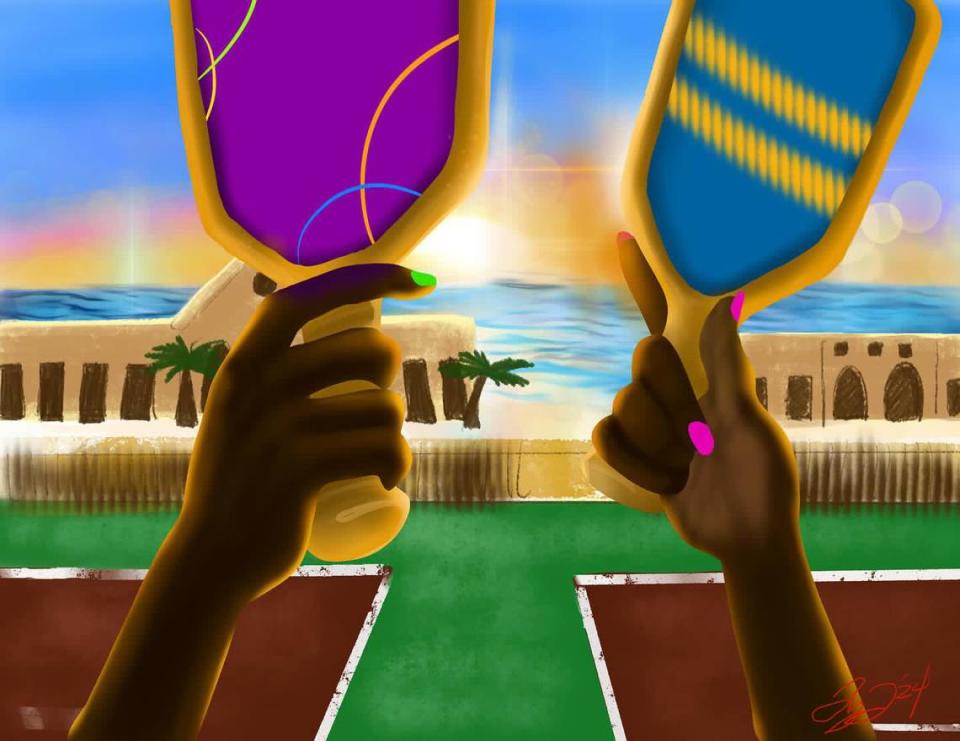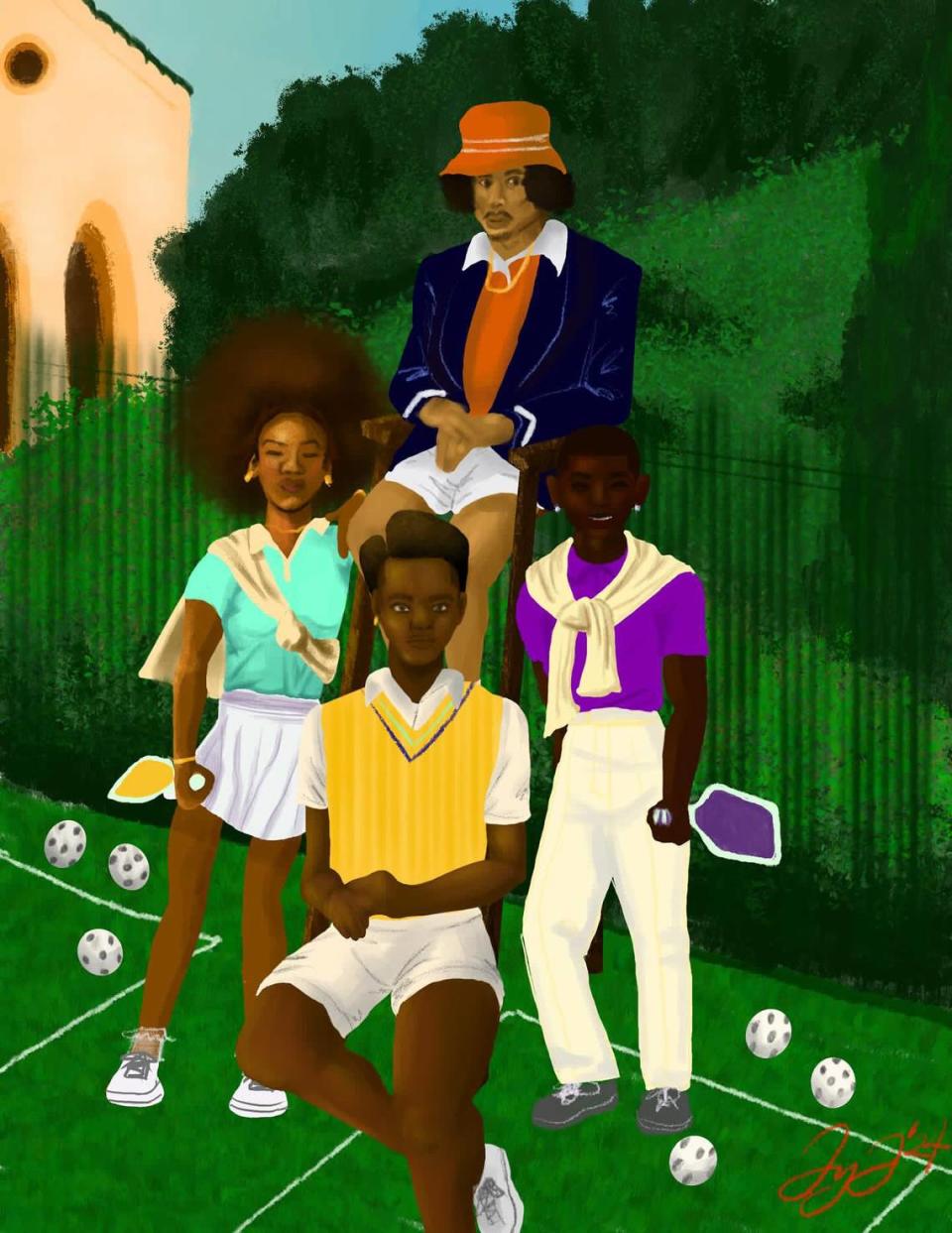Before There Was Pickleball, U.S.A.
Along with bragging rights to Arthur Ashe’s tennis legacy, Greater St. Louis, Missouri now boasts the largest indoor pickleball and padel complex in the world. It’s been a big deal: The local press, aficionados, and amateur players of both sports have offered up lofty praise, saying that the indoor facility ranks as nothing less than world-class, a rival to any to be found across the country.
And to be clear there’s no denying the structure, dubbed Padel + Pickle, is impressive, with its 14 lavishly appointed indoor courts, and trappings that include a bar and pro shop.
For me, however, as a native of the city’s Northside, marvels like these send my memory hurtling back to my youth and a past when games – touch football, kickball, and dodgeball to name a few – had less sheen. The trappings were modest. They were often fueled on nothing more than imagination, scraps, and ingenuity. The facilities we had and the equipment we used were makeshift, while the expanse of the competition ran as broad or narrow as the mind’s eye.
Little did we know, but the games that filled days drenched in sunlight and cloaked in stifling humidity were keepsakes.
Over time our parents and grandparents lovingly shaped these same games as vessels of culture to pass ahead. Each was a precious tincture brimming with essential lessons about how our predecessors understood and navigated life. In a quiet, lasting way, the laughter, the tension, smack talk, boastful strutting and even the hangdog moping shaped our outlook for years to come.

Anthropologists are fond of saying that games – and sport as well – are anchored to intention. Societies conceive them to mimic life in miniature. The social scientist Johan Huizinga put it this way: “It is through this playing that society expresses its interpretations of life and the world.” Take his thinking a bit further: Whether as players or spectators, competition imperceptibly serves as a staging ground where we test our strength, will, mettle and limits. Guidelines, boundaries, and rules both explicit and unspoken reflect the challenges we sense and the skills required to overcome them. The lessons learned from winning and losing teach us how to grab hold of destiny and shape it to our individual design.
On the Northside of St. Louis, each block had its own modest coliseum where all manner of competitive sport was staged: It was simply the alley that ran behind the houses where we lived. A modest, even battered surface, the alley stretched past our backyards away from the rumble of streets such as Hamilton, Labadie, Kossuth, Marcus or Margaretta. North St. Louis gamesmanship was anchored here on an all-purpose surface that we molded into a versatile playing field for any occasion. Urban planners meant for it to provide access to the garages where the family car was parked. Posses of kids like me in neighborhoods such as the Ville, Penrose, Fairground, O’Fallon, meanwhile, had another purpose in mind.
The hazards be damned. The surface was less than ideal and often flawed. The pavement was pocked and uneven. Footing was iffy. Down the center of the alley flowed a steady current of water – runoff from rainwater or lawn sprinklers. Occasionally, it swelled to a small torrent, one that was channeled by a gully near where I grew up. Between craters and divots lay dangers – strewn gravel and occasional shards of broken glass. Weeds jumped into cracks to set down roots not only where the edges came up to backyard gates, but sometimes down the middle.
Yet, for all its imperfections, the alley beat the street because cars drove through irregularly, especially during summer days when our parents were busy at work or home and we were set out to play until dinnertime. Sparse car traffic meant fewer interruptions for rough and tumble neighborhood combatants. Another big plus was just how malleable the alley turned out to be. For football, all we had to do was determine which fence, gate or garage on which property marked the end zone and seven points. The sole trick here was to keep from stumbling into metal garage doors which thundered like symphonic tympani when you tripped and collided into them.
If the contest du jour was basketball, we could ready the blacktop in no more than 30 minutes. For the portion of our alleway closest to Shreve, a few minor touches were all it took: One of us hacksawed the top two inches of a milkcrate to create a hoop in a jiffy. Another of us brought a ladder to climb, while the tallest nailed the crate remnant to a wooden telephone pole sometimes 10 feet above the asphalt, but then again maybe 11 or even 9 feet high. No matter. Game on.

The most elaborate alley game on the Northside was called ‘cork,’ short for corkball, a ‘formal’ game it was said White St. Louisans started maybe 70 years earlier. Corkball, the hallowed, orthodox version, was the city’s equivalent of stickball, equal parts batting practice and fantasy baseball. Our version, dubbed cork for short, had quirks aplenty like its forerunner, as well as a comically long scroll of rules. It required small sides – just a pitcher and catcher for a complete team of two and a far cry from the nine members required in baseball or softball. Runners were imaginary; their progress and scoring often determined by how far a batter hit a ball. The gear was equally odd - the official version of cork had specialized equipment, shrunken facsimiles of baseball staples including a ball the size of a robin’s egg and a bat no thicker than a closet rod.
In back alley laboratories on the Northside, our ‘cork’ was also put through a number of mutations, even while keeping fairly close to the original rules. My father’s generation saw fit to tinker with the type of equipment they fashioned out of what was handy. Truncated broomsticks sometimes became bats. If you had enough saved up to buy tennis balls, you needed to ready them for play, wrapping them first in newspaper, setting a match and burning off the fuzz. That left a surface of rust colored stubble, tacky enough to send the ball on a drunken spin up or down in the hands of a seasoned pitcher.
For the bareboned, hardened enthusiast, a pop bottle cap served as the ball. I have vivid memories of my dad showing my brothers and me the proper pitching technique. The trick was to let the spiked discus roll off his index finger with a snap of the wrist, sending it on a desperate parabola earthward, the waning flight of a cicada’s last gasp.
North St. Louisans were equally driven in formal sports but to get in the game often had to confront considerable barriers that they faced during segregation. Case in point: tennis. Richard Hudlin, a member of a famous family that grew up just outside St. Louis was so accomplished that he captained the University of Chicago’s tennis squad in college during the ‘20s. He returned to the St. Louis to teach at Sumner High and coach the secondary school’s team as a side pursuit. To stay in shape all year long, Hudlin needed somewhere to practice indoors during the Winter, but municipal tennis facilities such as the Armory blocked Black players from playing. In 1945, however, Hudlin won a lawsuit that opened access.
There are twin gems crowning Hudlin’s legacy, both connected to his work with some of Black America’s foremost tennis champions. Hudlin trained Althea Gibson, the first African American to win the French Open, Wimbledon and the U.S. Open. Hudlin also coached Arthur Ashe, the only Black man to win Wimbledon, the U.S. Open and the Australian Open. Hudlin connected with a young Ashe at the start of the 1960s. Ashe, a prodigy in his teens, was barred from using indoor courts in his native Richmond, Virginia to train during the winter. Hudlin took the budding star in, and Ashe finished high school at Sumner while honing his skills on the rapid-fire wood courts in the St. Louis Armory.
Unfortunately, there is scant if any tribute to Ashe in St. Louis. Hudlin family descendants include the tennis mentor’s great nephews Reginald and Warrington who enjoy notoriety elsewhere as film directors of Houseparty and Boomerang. Their website hosts a page to honor Richard’s contributions. Even so, it’s a shame that finding any physical marker to pay formal homage to Richard takes more effort than it should - this despite Hudlin’s direct link to Black tennis titans. A park outside the city in the suburb of Richmond Heights was dedicated to him in 2018 and features a plaque. Courts named in his honor once stood just south of a major hospital complex near Kingshighway. A parking complex swallowed those up in recent memory and all that remains is a plaque.
James A. Anderson is a professor at the Lehman College (Bronx) campus of the City University of New York, as well as a journalist, author and editor who writes on economics, urban planning, sustainability, music, and finance. His work has appeared in Time Magazine, Next City, Barron’s, Savoy among other publications.

 Yahoo Sports
Yahoo Sports 
